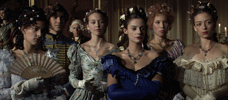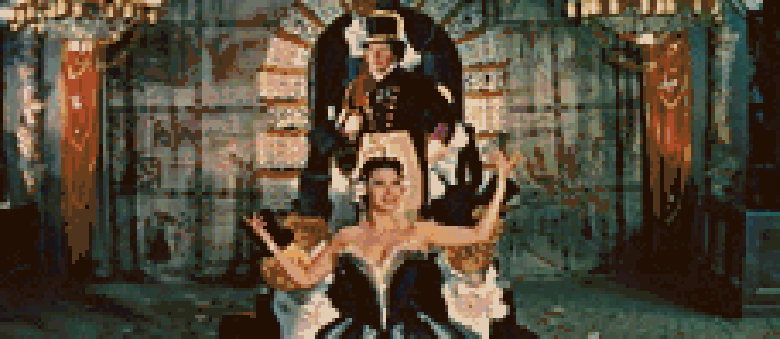Reviews
The Fall of Lola Montès
Max Ophüls
France / West Germany, 1955
Credits
Review by Evan Kindley
Posted on 03 October 2008
Source Rialto Pictures 35mm print
Categories The 46th New York Film Festival
The early fifties were a boom time for the circus as existential metaphor. First, in 1953, came Ingmar Bergman with Sawdust and Tinsel, followed in 1954 by Fellini’s La Strada. The next year, their elder Max Ophüls delivered Lola Montès, his final film, which also uses a circus to dramatize the fallen condition of modernity. All three of these directors exploit the circus’s familiar packaged surrealism, its subjection of the bizarre and unusual to the everyday control of the entertainment industry. But while Bergman and Fellini made scaled-down character dramas from this scenario and were primarily interested in circus performers as avatars of modern man (picking up the circus-freak-as-social-outsider topos laid down years before by Tod Browning), Ophüls alone is interested in the circus as an institution, as a relentlessly efficient machine for exploiting the eccentricities and excellences of exceptional human beings. And only Ophüls really stages a circus for us, one you find yourself actually enchanted and taken in by, complete with descending chandeliers, juggling showgirls, masked gymnasts, trapeze acts, horses, trap doors and secret elevators, puppet shows, multicolored midgets, and scale models of the world’s great opera houses.
The overwhelming extravagance of these sequences shouldn’t be surprising: Ophüls was always a maximalist, and he was also, in 1955, a commercial director, who had recently made a trio of crowd- and critic-pleasing pictures,1 and thus had carte blanche to make the most elaborate film he wished. (He succeeded, to the point of producing the most expensive movie up to that point in French history.) But the trend of Ophüls’ previous work can’t completely explain Lola Montès. Making his first film in Technicolor, one would expect it to be a candy-box, but Ophüls in fact favors a limited palette and hard, even unflattering lighting. Dealing with a minor subject, one would expect a frivolous romp along the lines of La Ronde, but Ophüls pushes for a resonance and grandeur that none of his other movies try for. Visually and tonally, the circus scenes are unlike anything Ophüls had done before. Indeed, while his earlier films are rightly seen as the apotheosis of the French “tradition of quality,” perfect of their kind but very much “of their kind,” Lola Montès is something else entirely, and the reference points it calls immediately to mind all come later in film history—the painterly splendor and machine precision of later Kubrick, the black comic camp of Fassbinder. At the same time as Ophüls displays his utter mastery of stagecraft in presenting us with the circus, he declines to give the images the sheen and polish of his earlier, prettier films: there’s a brutality to the treatment that never lets you forget you are watching a scene of exploitation. Rather than pirouetting around as in La Ronde or Madame de…, Ophüls’ camera stalks the ring with a starkness at odds with his usual graceful, fluid style, dutifully making the rounds, recording the spectacle but also the backstage machinations, preparations, and business dealings that keep it going.
Based on the real life story of Elizabeth Rosanna Gilbert, alias Lola Montez, an Irish-born dancer who became infamous as the mistress of both Franz Liszt and King Ludwig I of Bavaria, Lola Montès is structured as a theatrical recreation of the lead character’s life. Lola, now past her prime, has ended up as the star performer in an American circus, but she’s not there to dance. Rather, she is paraded around as an object of curiosity, envy, and contempt, as ill-tempered members of the audience call out questions about her past affairs. Martine Carol invests Lola, in these scenes, with a perfect Brechtian blankness, communicating no emotion whatsoever about her predicament. Peter Ustinov, as the unctuous master of ceremonies, is only slightly livelier, switching between French, German, and English as he addresses the crowd, the producers and (in a sinister undertone) Lola herself.
Interspersed with the circus scenes are flashbacks to the relevant moments of Lola’s history, shot in a more familiar, lush Ophülsian style. In stark contrast to the totalitarian modernism of the circus scenes, these flashbacks are like a nineteenth-century novel come to life. (If the circus is stylistically the “German” section of Lola Montès, then perhaps the flashbacks constitute the “French” section—light where the former is heavy. Though there is the fact that the former takes place in America and the latter mostly in Austria to contend with, thus setting up complex tonal ironies on the level of filmic technique.) Ophüls is famous for his precisely planned traveling shots, and these sections of Lola have plenty of them, but he also experiments with a host of other cinematic devices: placing the camera at a slanted angle, so we watch scenes play out at a diagonal; irising out half the frame with a horizontal line; or (particularly exciting for me, somehow) the moments when the camera rises directly up, as if riding an elevator, whether to follow Lola on to a bunk bed or to show the tiers of seats in a Bavarian opera house. The backgrounds, too, are consistently fascinating—Ophüls has an unfailing eye for details, inanimate and human alike, and much of the incidental business involving footmen could easily have been spun out, Jean Renoir-style, into separate storylines.
The question does arise, however, as it tends to do with Ophüls: is the film ultimately only about style? Admittedly, the plot is no great shakes, and once the film gets underway, one begins to wonder if all this cinematic opulence isn’t compensating for Ophüls’ relative disinterest in his material.2 But I would argue that Ophüls is highly interested, even invested, in the story he tells here, a story that is both a version of his own life story and a potted history of the nineteenth-century artist. (Short version: sustained by aristocratic patronage, threatened by proletarian revolution, only to be subsumed and repurposed by American-style capitalism in the end.) Far from the carnivalesque, but not quite reaching the heights of tragedy, Lola is condemned to the middle class, which for an artistic soul (Ophüls suggests) can only mean a life of hackwork and mediocrity. Lola Montès isn’t a tragedy, because Lola Montès, for Ophüls, never had a chance at being anything other than a failure; similarly, it isn’t a satire because Ophüls is a lot more interested in celebrating the beautiful world Lola brings down (or goes down with?) than in mocking it.
To put it another way, it’s not at all clear where the filmmaker’s sympathies lie, whether he shares the ringmaster’s contempt for Lola or not. (“We’ll show everything that women dream of doing,” the ringmaster says, a moment of cynicism that makes you wonder about the calculations behind Lola’s script.) It’s important to note that Lola, besides being a reminder of nineteenth-century aristocratic opulence, is also initially an outsider to that world: she is born poor, rises by virtue of her beauty and is seen as bringing an exotic novelty (Spanish dancing) into European culture.3 So rather than - or in addition to? - representing the lost splendor of old Europe to the American circusgoers who pay to see her, Lola may represent the decay of that very Europe’s classical standards. (In one scene, Ophüls points toward this complex of concerns by modeling the portrait of Lola commissioned by Ludwig on Édouard Manet’s Olympia, the famous image of a nude prostitute which scandalized Parisian academicians and which, for many art historians, marks the beginning of the artistic avant-garde. This unexpected reference suggests that Ophüls has an ambivalent relationship to modernism - or anyway modernity - which crystallizes in the ambivalent figure of Lola, the non-artist who represents both the temporary triumph of artistic values and their inevitable failure in the face of adverse public reaction.) In other words, how does Max Ophüls regard Lola Montès: as a hack or a fellow traveler? And when he looks back from the obviously awful predicament she ultimately finds herself in, is he nostalgic for the moment of her triumph, or for some ancien régime predating it?
You could make the argument either way, but I think Ophüls could probably say with some truth “Lola Montès, c’est moi.” True, Lola herself is not figured as a “real artist,” modern or otherwise, but at best a muse for them (she briefly dates Franz Liszt; it doesn’t work out). Like a nineteenth-century Zelig, she pops up at important historical moments but has little positive effect on them. She’s never more than a symptom of cultural change. “What have I to do with revolutions?” she asks a young leftist admirer who rescues her from the Bavarian revolts. The answer is nothing, really; Lola’s ultimate interest is not as a player in a historical narrative, or even as an artist accomplishing a revolution in the realm of taste, but rather as a succés de scandale, which for a clueless American public is all that survives of old world elegance anyway. But Ophüls himself, making his first truly Big Film after a career of exquisite journeyman-work, could say much the same thing: “What have I to do with masterpieces?” From this perspective, Lola is the patron saint of generations of Continental aesthetes, buffeted this way and that by historical contingency, unable to influence their surroundings or even find a position of relative stability from which to put forward a considered, lasting body of work. This was the condition of many artists in Europe in the nineteenth century, and also Ophüls’ condition in the first half of the twentieth, and the condition of many of the cast and crew who worked with him on Lola Montès: superb craftsmen from all over Europe, displaced by Hitler and Stalin, looking for a market to hawk their wares and, if they got really lucky, a chance to create some works of art.
The final shot of Lola Montès, which returns us to the present day, is, for my money, one of the most striking and meaningful in the history of cinema. It’s a fitting epitaph for Ophüls’ career (though of course he didn’t know it would be), exemplifying his innate formal elegance but also placing it in context. But it shouldn’t have been the end: Ophüls was only fifty-five when he died, after all. And Lola Montès, from another perspective, is best seen not as the culmination of a tradition, but as a masterpiece that in a perfect world would have started some new traditions of its own.
- These three films - La Ronde, Le Plaisir, and The Earrings of Madame de… - have recently been released on DVD by the Criterion Collection.↩
- This concern is not assuaged by a quote from Ophüls himself with regard to his heroine: “Lola Montès? That woman doesn’t interest me. It is the people who surround her that excite me. Her role is roughly the same as that of our pair of earrings in Madame de…”↩
- The fact of her Irishness is never mentioned in the film. Obviously this would have added yet another layer of international, not to mention colonial, intrigue. ↩
Lola Montès will also screen at New York City’s Film Forum for a three-week run beginning Friday October 10.
More The 46th New York Film Festival
-

Wendy and Lucy
2008 -

The Northern Land
2008 -

The Last Command
1928 -

Hunger
2008 -

Lola Montès
1955 -

Summer Hours
2008 -

Gomorrah
2008 -

Changeling
2008 -

Che
2008 -

I’m Gonna Explode
2008 -

Waltz with Bashir
2008 -

Happy-Go-Lucky
2008 -

The Windmill Movie
2008 -

Tulpan
2008 -

Afterschool
2008 -

A Christmas Tale
2008 -

The Headless Woman
2008 -

Bullet in the Head
2008 -

Four Nights with Anna
2008 -

Night and Day
2008 -

The Class
2008
We don’t do comments anymore, but you may contact us here or find us on Twitter or Facebook.



